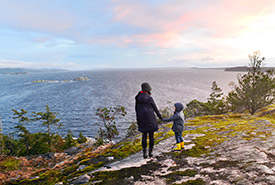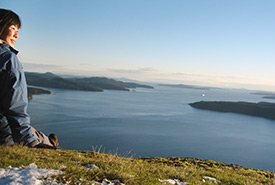Prescribing nature: From passion to international recognition

Melissa speaking about Parks Prescription at the Canadian Medical Association Health Summit 2023 (Photo by Birinder Narang)
Memories and experiences in nature can sometimes evoke a profound sense of wonder that compels someone to share its benefits with others. For Dr. Melissa Lem, president of the Canadian Association of Physicians for the Environment, encountering nature early in her childhood played a big role in inspiring a career advocating for the benefits of nature to all.
There are well-documented benefits of nature, from good health and well-being, to improved creativity and memory, activation of the parasympathetic system (e.g. rest and relax response), lowering salivary cortisol and many more. Nature’s soothing effects on the mind and body is perhaps something we’ve experienced at some point during our own time in nature. Hearing about the body of evidence reminded me that there is much more to understand in the relationship between healthy environment and healthy people.
I recently had the pleasure to catch up with Melissa about how prescribing nature has been flourishing in Canada and abroad, and what inspired her to champion nature as a lifestyle intervention.
“As a Chinese-Canadian girl growing up in a majority-White neighbourhood in Toronto, I didn’t always feel like I belonged. But when I think back to the moments spent in my dad’s garden, or the shade of the bushes and trees in the school yard, those places made me feel safe and comforted,” Melissa shares. “Seeing the impact of nature on my own well-being motivated me to share the message that nature is good for your health with people, especially children…that everyone needs access to high-quality nature.”
Here, I paused, reflecting on how my daughters gained a fascination with insects as toddlers and how they feel at ease in nature following our footsteps on hikes. I nodded in agreement over the phone.
One of the ways Melissa champions nature and health is through her work as founding director of the Park Prescriptions (PaRx) initiative in Canada, which helps health professionals prescribe nature. Since 2020, when PaRx launched, more than 11,000 regulated health professionals have registered, including over five per cent of all practising physicians in the country. In British Columbia, where the initiative started, an incredible almost 15 per cent of physicians have opted into the program!

Dre Melissa Lem et son fils, Red Granite Point, Ont. (Photo reproduite avec sa permission)
“The intuitive way you feel about spending time in nature being good for your health matches up with the evidence, which is great,” says Melissa. “That’s one reason why the medical community has really shown up to support this initiative. PaRx is also garnering international attention, being a co-investigator or advisor in three major research projects looking at the efficacy of nature prescriptions,” says Melissa. PaRx was also formally endorsed by the Canadian Medical Association (CMA) at COP15, and the Canadian Medical Association now recommends that medical students and practitioners be taught about the importance of prescribing nature.
Hearing Melissa share the latest developments was incredibly uplifting and inspiring. I wondered what a nature prescription looks like, and what is the difference between using self-help materials and a PaRx?
Melissa explained that research shows patients are more likely to adhere to a prescription when it’s formalized. Not only is there a sense of accountability, but nurses and doctors are also among the most trusted professionals worldwide, according to annual surveys. The program also provides ways to reduce barriers to nature access. A prescription typically looks like at least 20 to 30 minutes of time in nature per day, and at least two hours per week. A prescription may also involve time spent connecting with nature indoors if a patient has difficulty heading outside.
When asked about how interested individuals can bring up PaRx in their next doctor’s visit, Melissa suggests starting the conversation in a casual way with your nurse, doctor or psychotherapist, for example. Any regulated health professional can enroll in the program, and sharing the website, parkprescriptions.ca, is a good starting point.
As we neared the end of our chat, I asked Melissa about a favourite memory in nature. She described her experiences on the Southern Gulf Islands of BC, where she is a rural family physician.

Dr. Lem and the view at Mount Galiano, BC (Photo courtesy of Melissa Lem)
“The first time I worked on Galiano Island I decided to go for a birthday hike by myself, after doing some research and discovering there were no big predators there,” Melissa says, chuckling. “I hiked up Mount Galiano with no idea of what I was going to see. I just remember coming around the corner and seeing this incredible, sweeping view opening up over the ocean towards Mayne Island. There was a bit of snow on top of the mountain, and I thought, I’m so glad to be back here in nature, where I belong.”
Melissa’s enthusiasm and work demonstrate how combining one’s passion for a healthy planet and human health can inspire others to foster their own well-being and, through a connection with nature, find a happy path to action.
Editor’s note:
- As of July 2024, there are 14,000 health professionals registered in the program, including seven per cent of all physicians.
- The federal government also included PaRx as a prominent case study in the Climate Action section of its 2024 Annual Report on the 2030 Agenda and the Sustainable Development Goals — underlining how nature prescribing can improve planetary health too.
- The program saw new collaborations take place:


